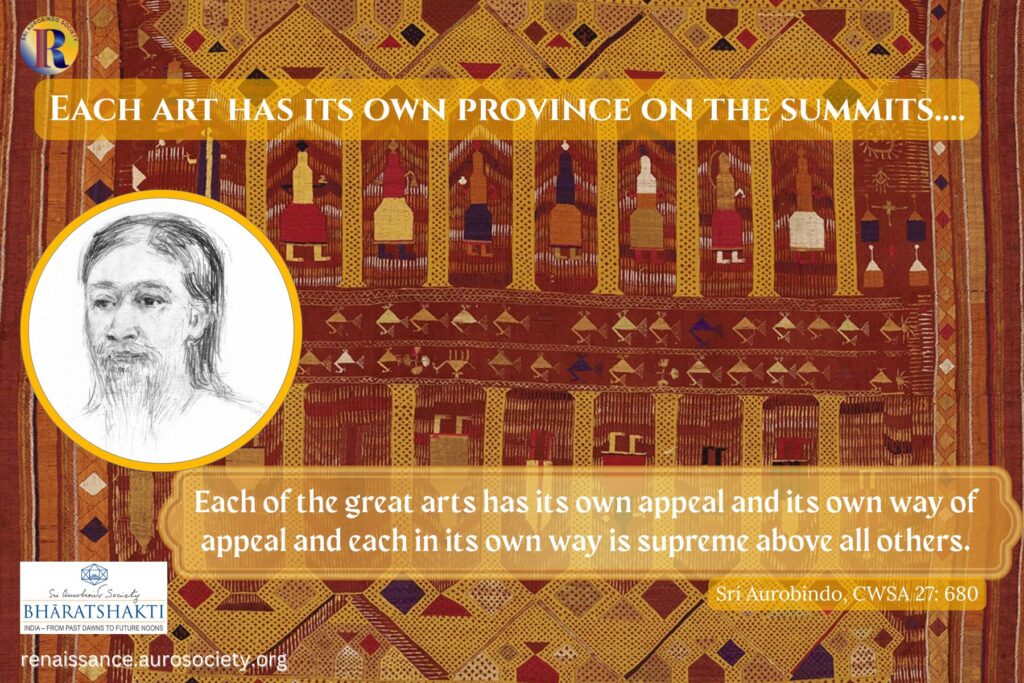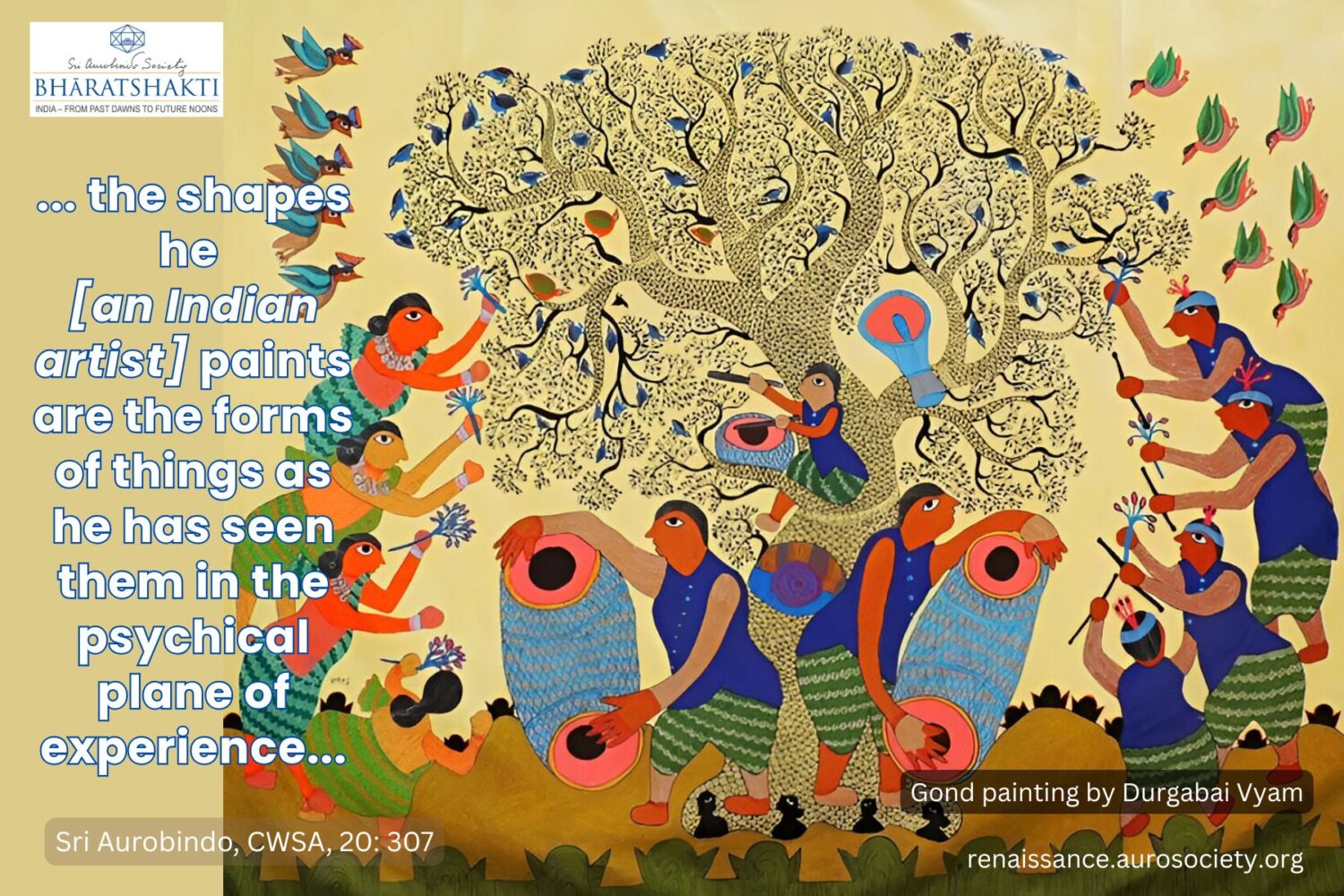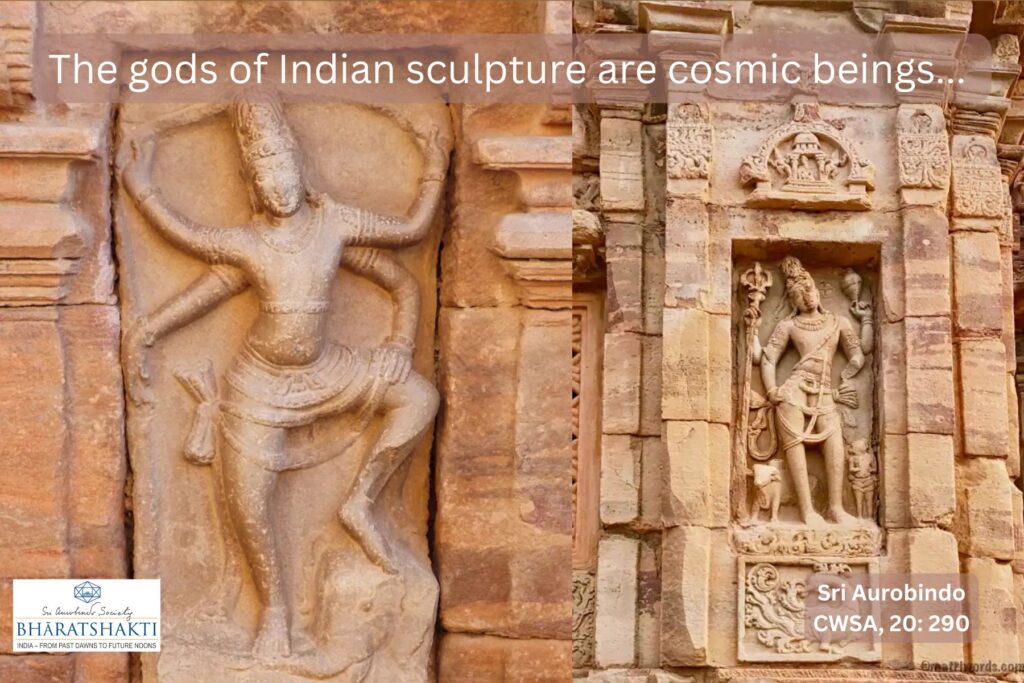Volume II, Issue 1
Author: Beloo Mehra
Namaste!
Greetings for Summer Solstice and International Yoga Day!
We are happy to re-launch our monthly e-journal after a gap of more than a year. Centered around a specific theme each issue of Renaissance will have a rich variety of inspirational reading and reflection material. These will include:
- selected passages from the works of Sri Aurobindo and the Mother (in our Guiding Light section);
- carefully curated and updated essays from early sādhaka-s and scholar-practitioners of Integral Yoga (from the archives of journals published by organisations connected with the vision and work of Sri Aurobindo and the Mother);
- featured book of the month (book reviews or book excerpts);
- insightful conversations with authors, storytellers, educators, artists, subject experts and more;
- articles and reflections from contemporary writers;
- stories, artworks, anecdotes, travelogues, special features, and much more.
Yoga – that’s the theme for our present issue, chosen to mark the International Yoga Day.
Brahman, Yoga and Dharma – these are India’s answers to man’s continual quest, said Sri Aurobindo once. And he explained further:
“What Science could not provide India offers, Brahman for the eternal goal, Yoga for the means of perfection, dharma (swabhavaniyatam karma) for the rational yet binding law of conduct. Therefore, because it has something by which humanity can be satisfied & on which it can found itself, the victory of the Indian mind is assured.” (CWSA, Vol. 12, p. 64)
It is prudent to recall the Mother’s words here that perfection does not mean a maximum or an extreme, it is actually an equilibrium and a harmonisation.
So yoga is that inner discipline which helps us arrive at an inner equilibrium and harmony. The highest harmony is the union with the Divine, the inner and true Truth behind the outward and the apparent. The path of yoga was once illustrated perfectly and beautifully and most simply yet profoundly through a drawing.
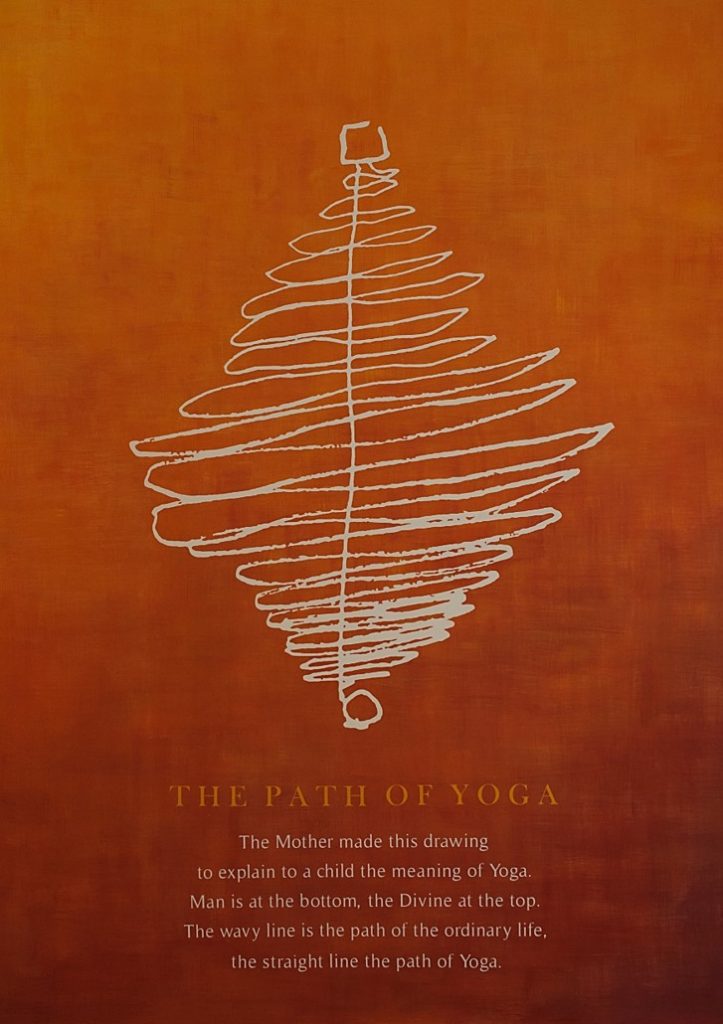
Yoga is that conscious route which takes the human to the divine through a straight path, whereas in the pursuit of our ordinary living, we traverse the same journey, but through a great zig-zag of many, many lives.
In our Guiding Light section of this issue, through three remarkable passages from the Mother and Sri Aurobindo we learn of the fundamental difference between Integral Yoga and other paths of yoga. The Mother reminds us that in integral yoga it is in life that the Divine must be found, not outside life.
Speaking of the evolutionary aim in Integral Yoga, Sri Aurobindo says that Supernature is, in every way, our aim in Yoga, which he describes as – “being still natural to the world, to transcend Nature internally so that both internally and externally we may possess and enjoy her as free & lord, swarat and samrat.” (CWSA, Vol. 12, p. 114). Read the full passages to appreciate fully. Finally, in the third passage, commenting on a letter of Sri Aurobindo, the Mother emphasises on a complete change and transformation of outer nature as the goal of Integral Yoga.
“There are two powers that alone can effect in their conjunction the great and difficult thing which is the aim of our endeavour, a fixed and unfailing aspiration that calls from below and a supreme Grace from above that answers.”
(Sri Aurobindo, CWSA, Vol. 32, p. 3)
This opening line of the book titled ‘The Mother’ can be understood as a core mantra for the sādhaka of Integral Yoga.
In this little but highly profound book, we also find a great summary of what Sri Aurobindo calls as the triple labour of aspiration, rejection and surrender – the fundamental processes of Integral Yoga. In our Sunlit Path series, we highlight selections from some of the letters written by Sri Aurobindo to early disciples explaining this triple labour.
We also feature an essay which was first published in the 1952 issue of the annual journal, Sri Aurobindo Circle. In this luminous writing, Nolini Kanta Gupta, who came to be known as Sri Aurobindo’s mānasputra, speaks of the inner light that illumines the aspirant’s path, and emphasises the value of sincerity, openness and a clear inner discernment as prerequisites on the yogic journey.
Continuing with our theme of yoga, we have selected three brief passages from Amal Kiran’s writings from the archives of Mother India journal. In the first passage, he gives us a brief introduction to Sri Aurobindo as the greatest yogi of our age. And in the second and third, he speaks of what is unique about the Integral Yoga, which as elaborated by Sri Aurobindo and set on a manifold practical basis promises the emergence of a new state of consciousness by which every one of our persisting problems, individual and collective, will be radically solved.
Amal Kiran points out that Sri Aurobindo’s Integral Yoga seeks to divinise the entire self by a special experience and ultimately permeate with a spiritual power of consciousness every means of manifestation and the entire outer form so that even the poor body which lives a victim to disease and decay and the sudden stroke of death may become king of Nature.
In a letter to a disciple, dated 21 June, 1937, Sri Aurobindo wrote:
“…it is not by upadeśa that this sadhana is given or carried on. It is only those who are capable by aspiration and meditation on the Mother to open and receive her action and working within that can succeed in this Yoga.”
(CWSA, Vol. 32, p. 136)
Taking inspiration from these words, we begin with this issue a series titled ‘Sādhanā’ in which we will share a selected prayer or meditation as an expression of our aspiration for the inner work each of us must do for a true renaissance of India. This month we take a prayer from the Mother’s Prayers and Meditations, dated June 21, 1914.
A true rebirth of the ancient spirit and soul of India into a new body of energy, in a new form is possible only when we insist much more integrally on the greater and greater action of the spiritual turn and motive in every sphere of our living. This series expresses our approach to the work we do at Renaissance – in the spirit of sādhanā, as an offering to the Divine Mother.
Cheerfulness is the salt of sādhanā, said Sri Aurobindo once.
Inspired by that, from this issue onward we will have a new series titled ‘Divine Humour’. For this issue, we bring three short anecdotes recounted by Nirodbaran – an early disciple with whom Sri Aurobindo shared a special friendship as is evident in their voluminous correspondence – during his talks at Sri Aurobindo International Centre of Education. We also bring for our readers a delightful and profound parable narrated by Sri Ramakrishna.
The featured Book of the Month is ‘Mystery and Excellence of the Human Body’, edited by Kireet Joshi. We present a brief excerpt highlighting the glorious tradition of physical education in ancient India. We highlight how ancient India emphasised the pursuit of an integral aim of life, which created a system of integral education that valued both the material and spiritual poles of the being.
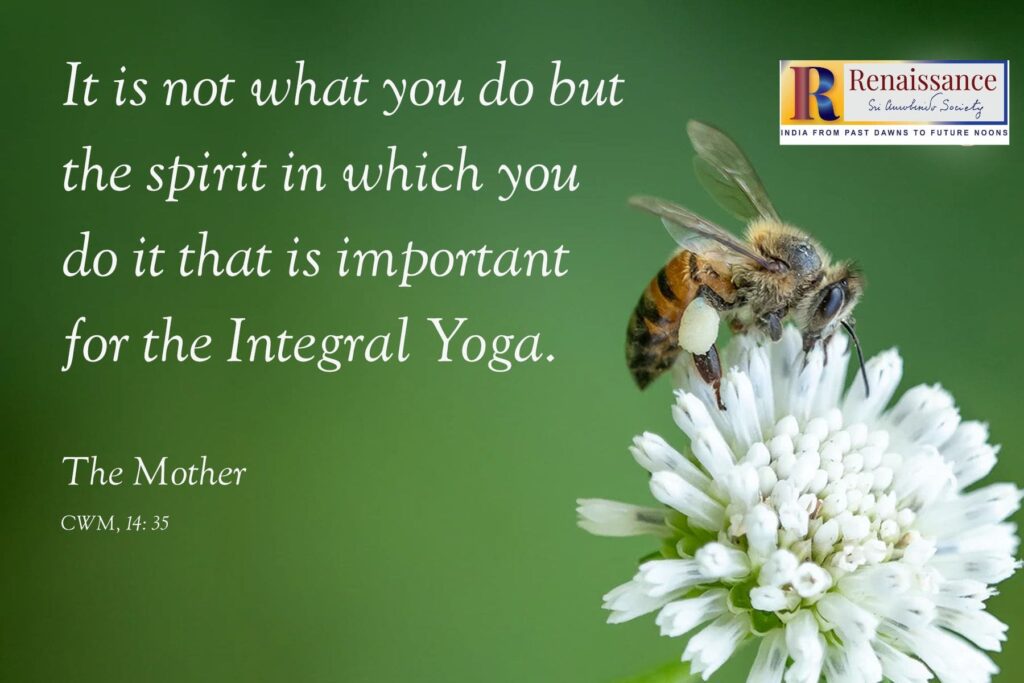
We believe that it is to make the yoga the ideal of human life that India rises today; by the yoga she will get the strength to realise her freedom, unity and greatness, by the yoga she will keep the strength to preserve it.
~ Sri Aurobindo, CWSA, Vol. 8, p. 24
In Insightful Conversations, we have two exciting offerings for our readers.
First, we speak with a well-known name in Yoga education, therapy and research, Yogacharya Dr. Ananda Balayogi Bhavanani. He is the Director of the Centre for Yoga Therapy Education and Research (CYTER), and Professor of Yoga Therapy at the Sri Balaji Vidyapeeth University, Pondicherry. We speak with him about a topic of great significance for our times – “Yoga and Cultural Misappropriation.”
Why are we witnessing today so much of cultural misappropriation of yoga by decontextualising it from or simply erasing its dharmic context? To what extent is the cultural uprootedness of Indians combined with a deep-seated colonisation of the Indian mind responsible for this cultural misappropriation? These and many other questions are addressed in this conversation. Do watch the full video.
Second, we feature Auroyajna – a new vertical at Sri Aurobindo Society, which aspires to offer its work toward the vaster goal of ‘the Divine Life in the Divine Body’ by contributing its services toward bringing about a shift in the present attitude of the humanity which sees the mortality of the body as the endpoint of life.
In an interview given to Isha Bidwaikar, the Auroyajna team explains that while the world is definitely moving towards a better health consciousness, Yoga is not and should never be a mere tool to recover from illness. Yoga is an attitude to be adopted with the aim of evolving in one’s consciousness, with an aspiration to progress from the ordinary limits of human experience to something that is beyond – richer, higher, vaster and deeper. Read the insightful interview to know more about various programmes and services offered by Auroyajna.
We are all aware that the last year and a half have been an unprecedented time for the whole world in many ways. Despite the large-scale suffering and considerable loss of life in many parts of the world, one of the positive outcomes of the resulting churning that has taken place during this time has to do with a greater interest in natural and holistic approaches to healing and wellness. It brings to mind one of Sri Aurobindo’s aphorism:
“The healthiest ages of mankind were those in which there were the fewest material remedies.”
~ Sri Aurobindo, CWSA, Vol. 12, p. 475
Starting with this issue, we bring for our readers a series of articles written by a natural wellness practitioner who has done extensive research in rural India to study and practice traditional healing methods and folk remedies. Her series, titled सर्वे सन्तु निरामयाः highlights for us some of the remarkable indigenous knowledge of natural approaches to holistic health and wellness that we have inherited from our ancestors, but have somehow forgotten during the course of time.
We hope our readers will enjoy going through this issue as much as we enjoyed putting it together. We thank you for your continued support of Renaissance. Some of our readers may be interested in browsing through Renaissance archives, especially the June 2019 issue which also had Yoga as its theme.
We also take this opportunity to invite interested writers to contribute to the journal. Click for more details on how to submit your articles, short stories, poetry, artwork for our consideration.
It is our sincere hope that our readers will enjoy going through this issue as much as we enjoyed putting it together. We thank you for your continued support of Renaissance.
As always, we offer this work at the lotus feet of Sri Aurobindo and the Mother.
In gratitude,
Beloo Mehra (for Renaissance Editorial Team)

